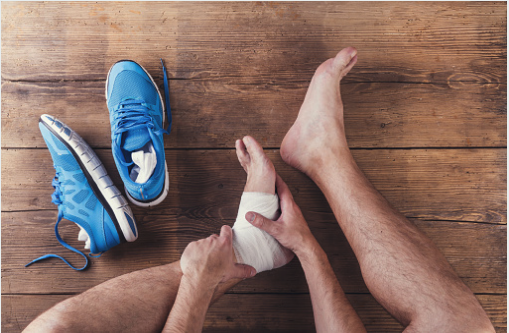A Sprain, strain, and tear–these types of injuries can occur at any time, especially when you workout. Many times when you’re running, jumping or even lifting, you can get injured, which is why it’s important to know the difference and how to fix the problem.

Sprain: Ligament injury
A sprain involves the overstretching or tearing of the ligaments, which are the fibrous connective tissues that connect bones to each other and stabilize them. “Sprains occur when the joint is forced into an unnatural position,” Mufich said. “They happen most often in the ankle but can occur at any joint, such as the wrist or knee.” Ligament injuries on the outside ankle occur when the ankle turns outward and the foot twists inward. On the other hand, inner-ankle sprains, which are less common than those on the outside of the ankle, result from the ankle rocking inward and the foot turning outward.
Joint or muscle pain, inflammation, hampered movement, tenderness and bruising are symptoms of a sprain. The severity of the sprain can range from mild to serious. A tweak of the ankle could result in an overstretched ligament that becomes tender, swollen and stiff, but the ankle should still be stable enough to support the weight of walking. “A mild sprain should take approximately seven to 10 days to heal,” Mufich said. “A torn ligament is considered a severe sprain that will cause pain, inflammation, bruising and result in ankle instability, often making it difficult and painful to walk. Recovery from a torn ligament may take several weeks, and should be done under the supervision of a health care provider.”
Strain: Muscle or tendon injury
A strain is the overstretching or tearing of a muscle or tendon, which are the fibers that connect the muscles to the bones. They can occur from a single incident or from repetitive movements over the long term. “An acute strain is an instantaneous stretch or tear of the muscle or tendon;” Mufich said, “whereas, a chronic strain stems from repetitive motions over time that place stress on the muscle or tendon.”
Muscle spasms, weakness, cramping and immobility, as well as pain, bruising and swelling are symptomatic of a strain. Like sprains, strains vary in severity. It could take a few weeks for the symptoms of a mild-to-moderate strain to subside.
Tear: Ligament, muscle or tendon injury
Tears are the ripping of fibrous tissue that can occur in the ligaments, muscles or tendons from similar activities that cause fibers to overstretch, but the diagnosis is more serious and muscle and tendon tears could take multiple months to heal. “Typically, the worse a tear, the more inflammation, and pain a person will experience, and the longer it will take for the injury to heal,” Mufich said. Non-surgical rehabilitation is often sufficient. However, some tears may require surgery to repair, such as those to the anterior cruciate ligament, or ACL.
Treating sprains, strains and tears consist of taking steps to reduce the swelling and pain from the injury. Swelling is often the body’s first reaction for healing an injury. As fluid and white blood cells rush to the damaged tissue, it becomes inflamed in an effort to repair the tissue and protect it from further damage. However, the fluid can compress the nerves in the injured area and cause pain. Excessive swelling can also potentially lessen the ligaments’, tendons’ and muscles’ flexibility, making the area more susceptible to future injuries. Mufich said these injuries are generally treated by following the plan “RICES.”
Rest: Unpainful movement of the area is important, but avoid putting weight on the injury for a prolonged time, perhaps by using crutches, until it is less painful to use
Ice: Apply ice, not heat, to the affected area for 10 to 20 minutes every hour or two throughout the first 24 to 72 hours or until the swelling subsides
Compression: Wear an elastic compression wrap for the first 24 to 36 hours to help minimize any swelling
Elevation: Rest the injury above heart level for two to three hours per day to reduce the amount of swelling that collects in the body’s extremities
Stabilization: Especially if medical care is not readily available, like in the wilderness, stabilize the injured area until care becomes available
“Particularly for muscle injuries, the blood works to lay collagen layers on the injury to heal it by forming an internal scab,” Mufich said, “and hopefully over time, as the muscles fibers heal, that collagen will break down.” Ligaments and tendons do not receive as much blood flow, so they tend to take longer to heal.
Sprain, strains, and tears can generally be prevented by adequately warming up and stretching prior to rigorous activity, wearing protective equipment, wearing properly fitting shoes that provide stability and building and maintaining muscle and joint strength by exercising regularly.
“While it is great to push your limits, know your limits,” Mufich said. “If you are not seeing improvements within 24 hours or it is getting worse, contact a health care provider.”